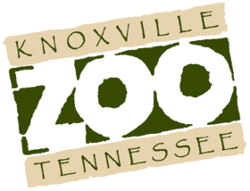Knoxville Zoo
 | |
| Location | Knoxville, Tennessee, USA |
|---|---|
| Coordinates | 36°00′00″N 83°53′17″W / 35.9999°N 83.8880°WCoordinates: 36°00′00″N 83°53′17″W / 35.9999°N 83.8880°W |
| Land area | 53 acres (21 ha)[1] |
| Number of animals | 800 |
| Annual visitors | 400,000+[1] |
| Memberships | AZA[2] |
| Website | www.knoxville-zoo.org |
Knoxville Zoo is a 53-acre (21 ha) zoo located just east of downtown Knoxville, Tennessee near exit 392 of Interstate 40. The zoo is home to about 800 animals and welcomes over 400,000 human visitors each year.
The zoo is accredited by the Association of Zoos and Aquariums (AZA).
Exhibits
The zoo features many naturalistic outdoor habitats for its animal residents, including:[1]
- Animal Encounter Village
- Black Bear Falls
- Chimp Ridge
- Grasslands Africa
- Meerkat Lookout
- Stokely African Elephant Preserve
- The Boyd Family Red Panda Village
- The Clayton Family Kids Cove
Indoor exhibits at the zoo include the Night Club, the Barn Loft, and a large reptile collection.
Attractions for children include the Clayton Family Kids Cove,[3] which opened in 2005, the Wee Play Zoo, and a new indoor play area.
Animals
Mammals
- African Elephant
- African Lion
- African Wild Dog
- American Black Bear
- Bengal Tiger
- Blue Monkey
- Cheetah
- Chimpanzee
- Geoffrey's Marmoset
- Hamadryas Baboon
- Indochinese Tiger
- North American River Otter
- Plains Zebra
- Prairie Dog
- Red Panda
- Red Wolf
- Reticulated Giraffe
- Snow Leopard
- Southern White Rhino
- Thomson's Gazelle
- Waterbuck
- Western Lowland Gorilla
- White-Handed Gibbon
Birds
- African Grey Parrot
- Andean Condor
- Black-footed Penguin
- Red-legged Seriema
- Roseate Spoonbill
- Scarlet Macaw
- Southern Ground Hornbill
- Toco Toucan
- American Eagles
Reptiles
- Aldabra Giant Tortoise
- Alligator Snapping Turtle
- Bog Turtle
- Chinese Alligator
- Eastern Diamondback Rattlesnake
- Gila Monster
Conservation
The Knoxville Zoo has been successful at breeding several endangered species, especially Red Pandas and White Rhinos. The zoo also bred the first African elephant in captivity in the western hemisphere, in 1978.[4]
In 2009, Sarah Glass, Curator of red pandas and Special Exhibits at the Knoxville Zoo in Knoxville, Tennessee, was appointed as coordinator for the North American Red Panda Species Survival Plan.[5] The Knoxville Zoo has the largest number of captive red panda births in the Western Hemisphere (101 as of August 2011). Only the Rotterdam Zoo in the Netherlands has had more captive births worldwide.[6][7]
Partnership with Mozilla Firefox
By the end of 2010, Mozilla Foundation—the creator of Firefox Web browser—partnered with Knoxville Zoo in an effort to raise the awareness about endangered red pandas. Two red panda cubs born at the Knoxville Zoo have officially become a part of the Mozilla community. The cubs were named Spark and Ember by online voters, and Mozilla broadcast a 24 hour live video stream of the cubs.[8][9]
Notes
- ↑ 1.0 1.1 1.2 "Zoo FAQs". knoxville-zoo.org. Knoxville Zoo. Retrieved 13 December 2010.
- ↑ "List of Accredited Zoos and Aquariums". aza.org. AZA. Retrieved 13 December 2010.
- ↑ "The Clayton Family Kids Cove". knoxville-zoo.org. Knoxville Zoo. Retrieved 21 February 2010.
- ↑ "Did You Know". knoxville-zoo.org. Knoxville Zoo. Retrieved 21 February 2010.
- ↑ Pounds, Jessie (1 April 2009). "Knoxville Zoo keeper adds red panda conservation efforts to job duties". knoxnews.com. Knoxville News Sentinel. Retrieved 13 December 2010.
- ↑ Glatston, Angela (2007). Red Panda International Studbook -Ailurus fulgens fulgens held in zoos in 2006. Rotterdam Zoo. Retrieved 2009-09-13.
- ↑ Glatston, Angela (2007). Red Panda International Studbook -Ailurus fulgens styani held in zoos in 2006. Rotterdam Zoo. Retrieved 2009-09-13.
- ↑ Meet the Newest (and Cutest) Mozillians
- ↑ Firefox Live Blog with Knoxville Zoo
External links
| |||||||||||